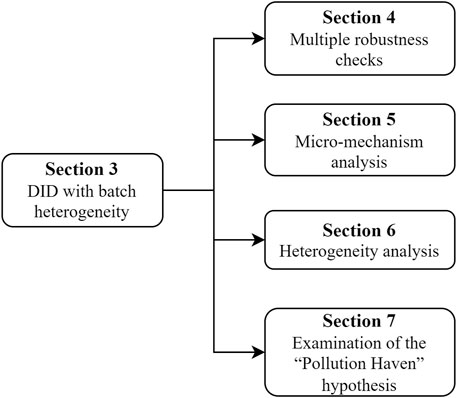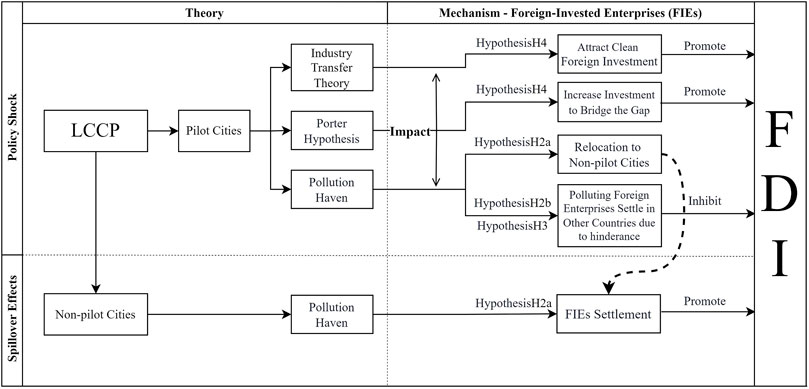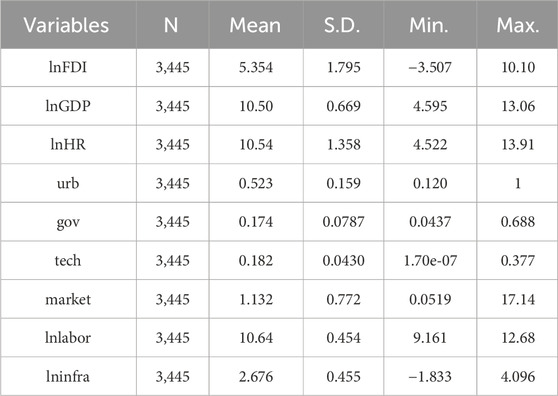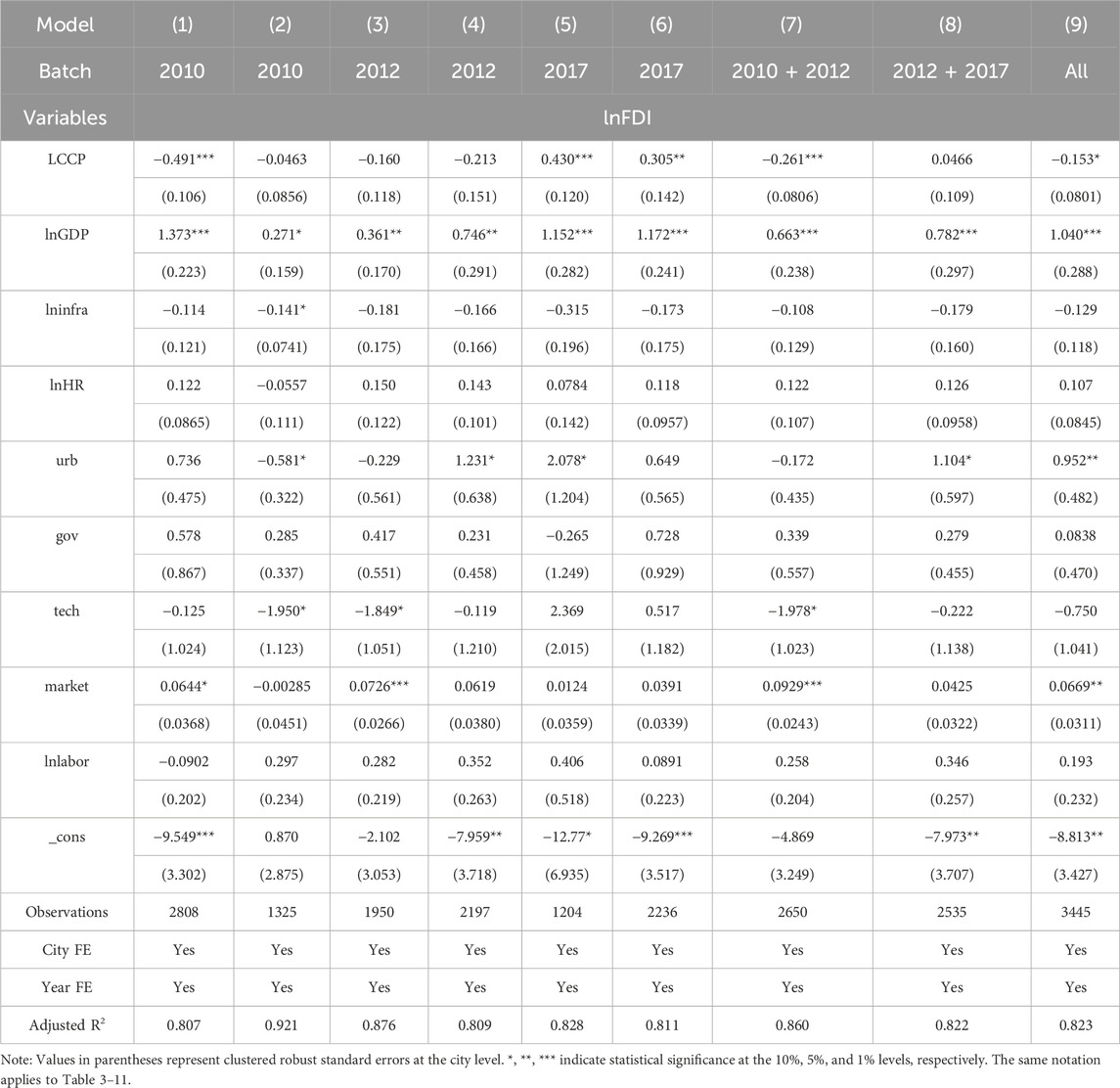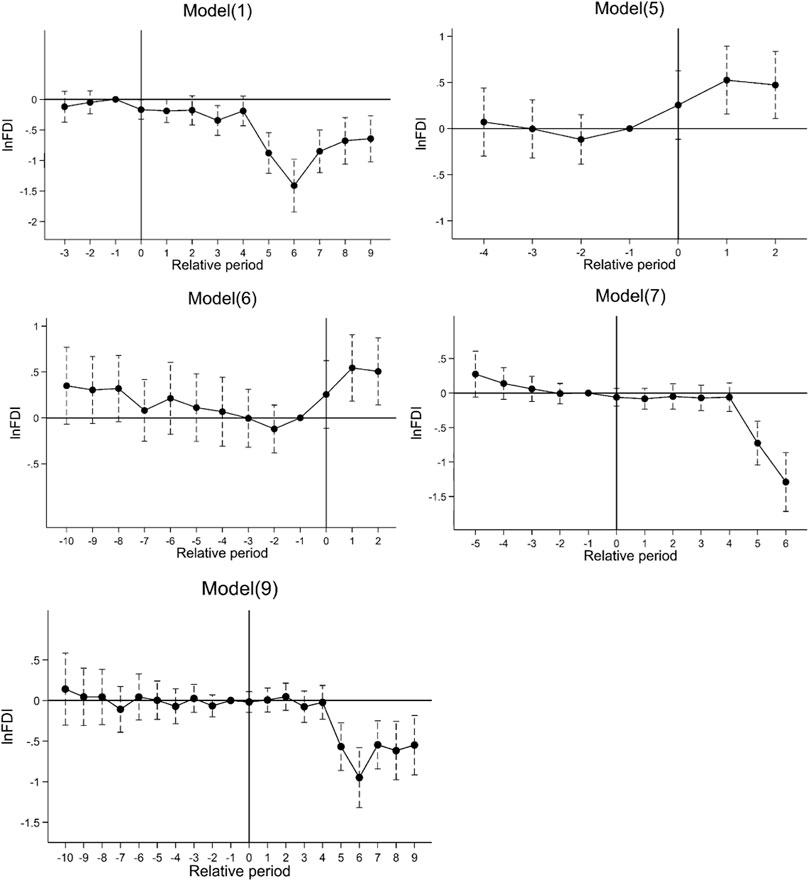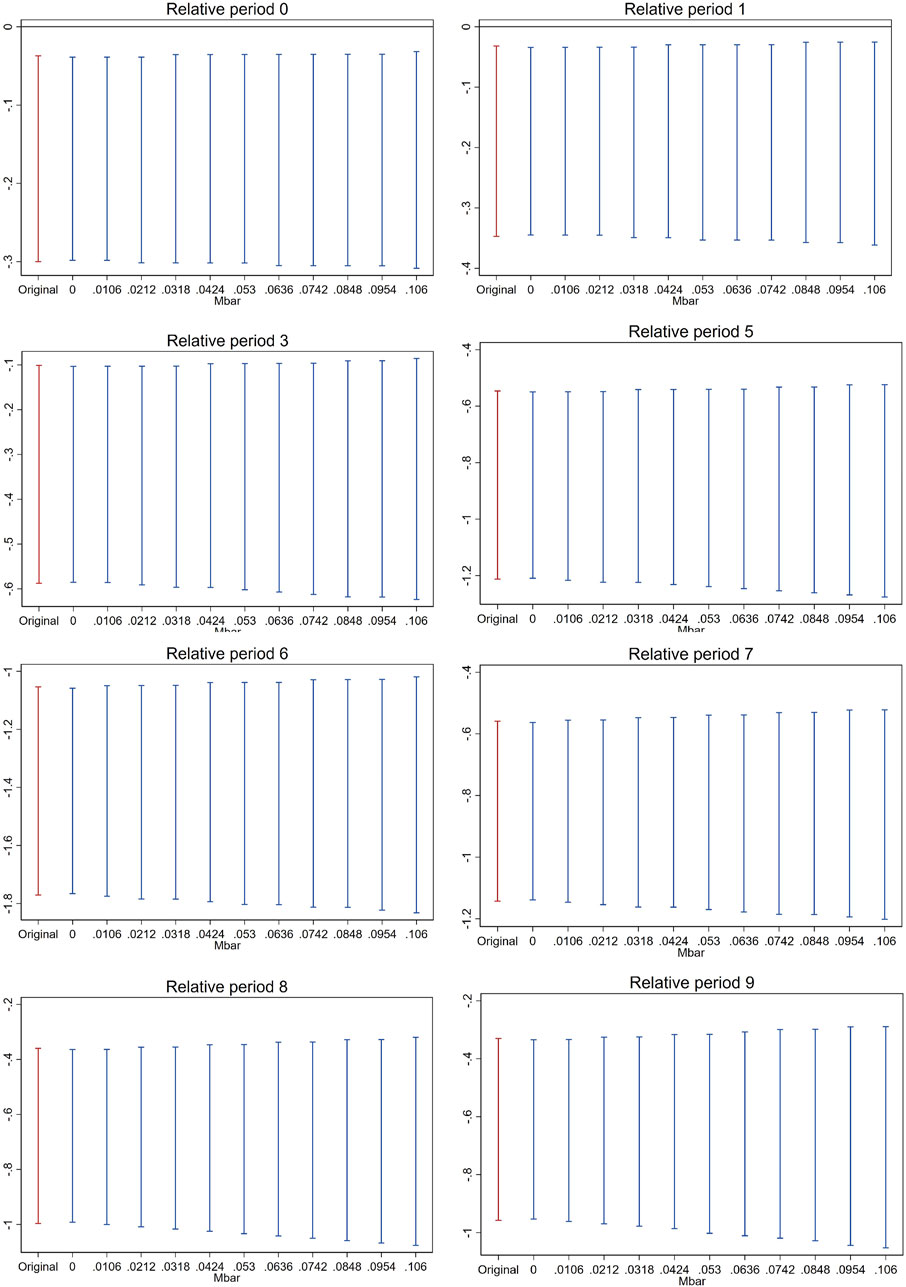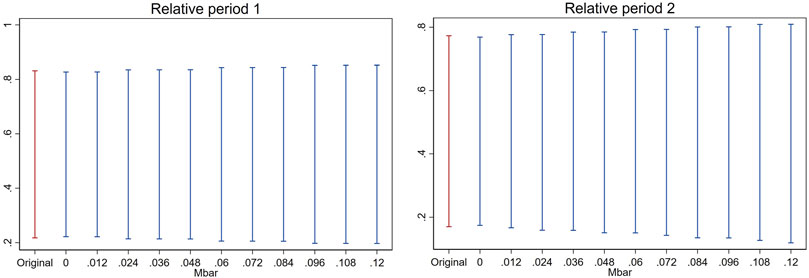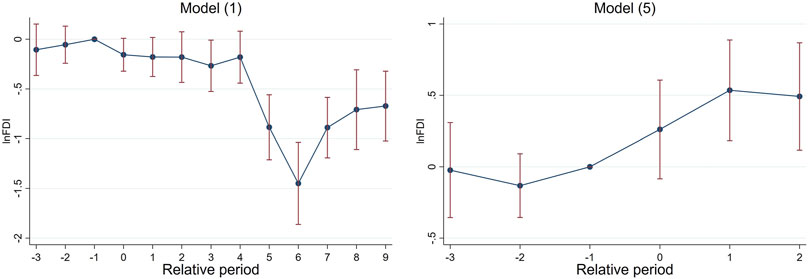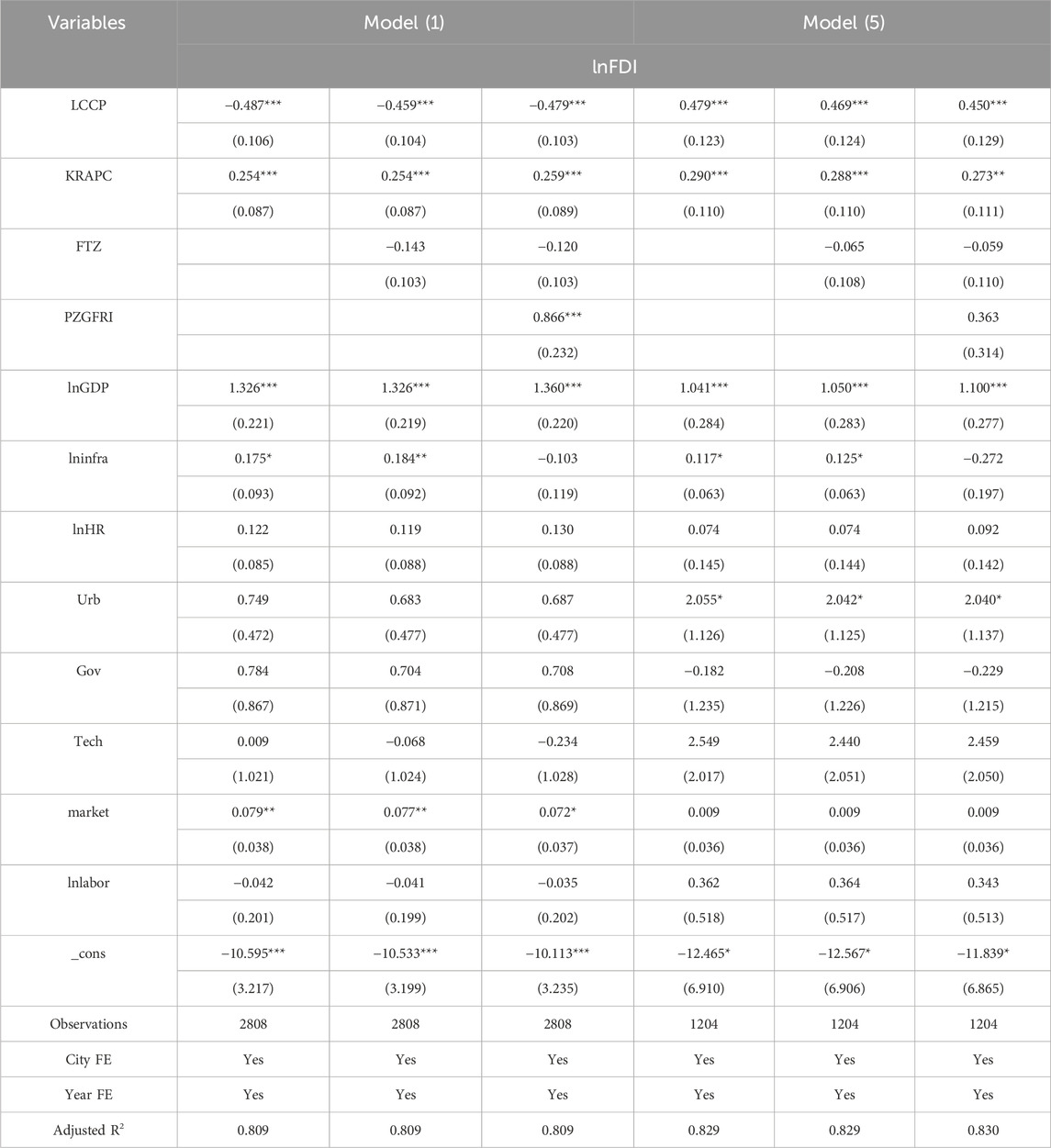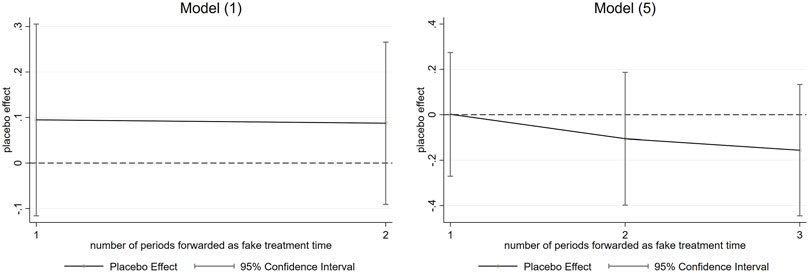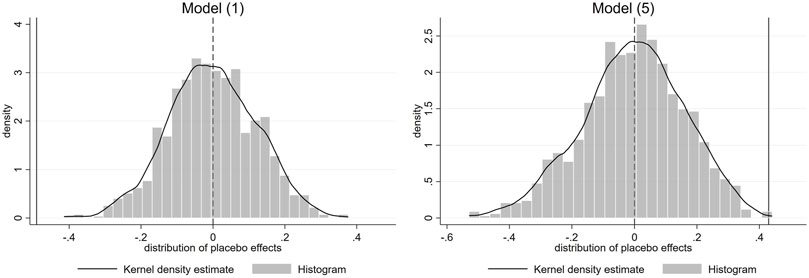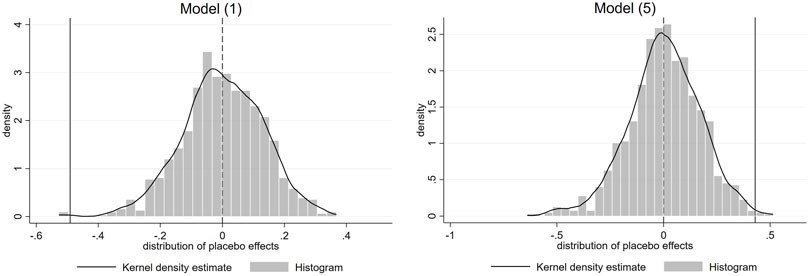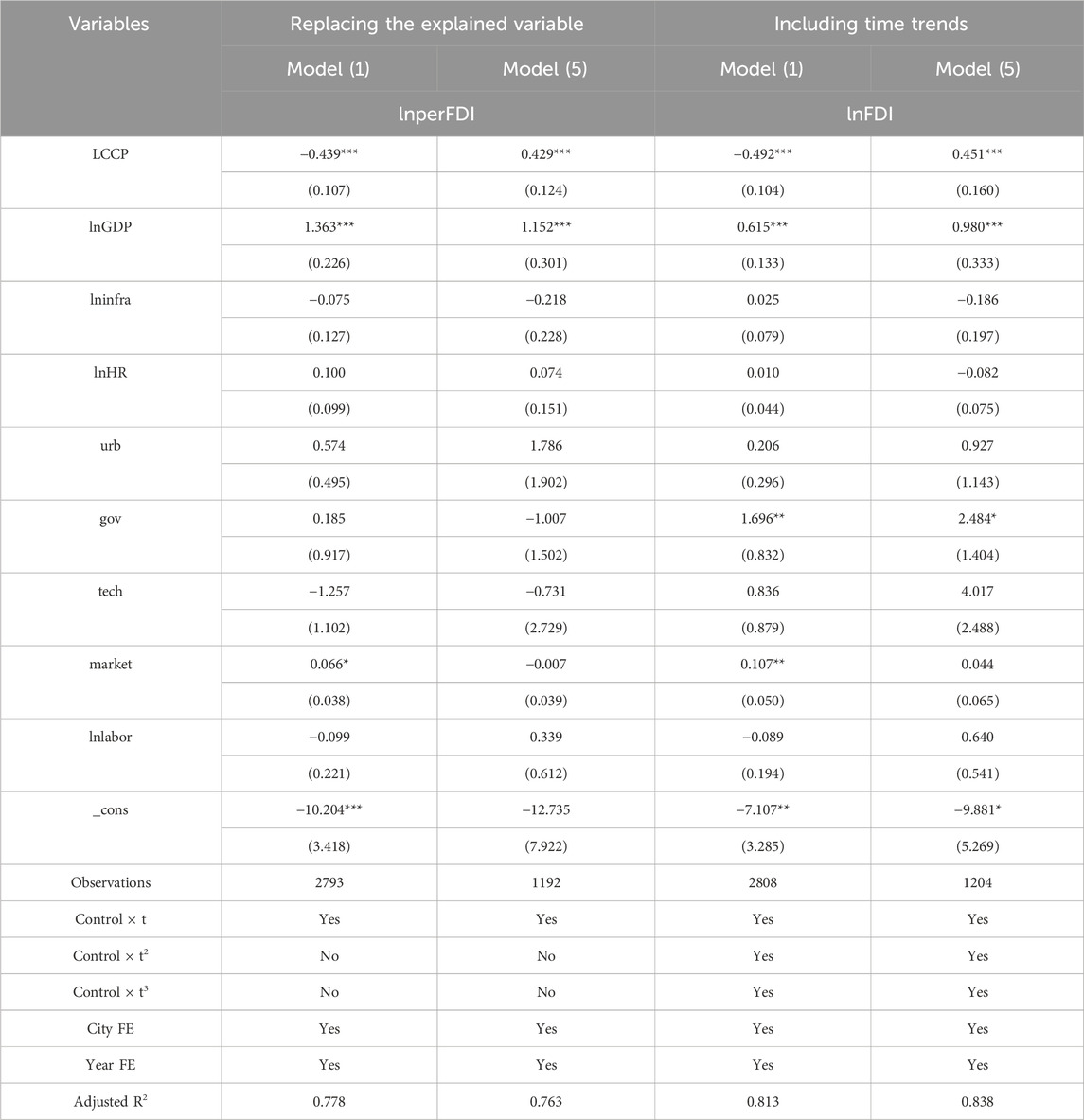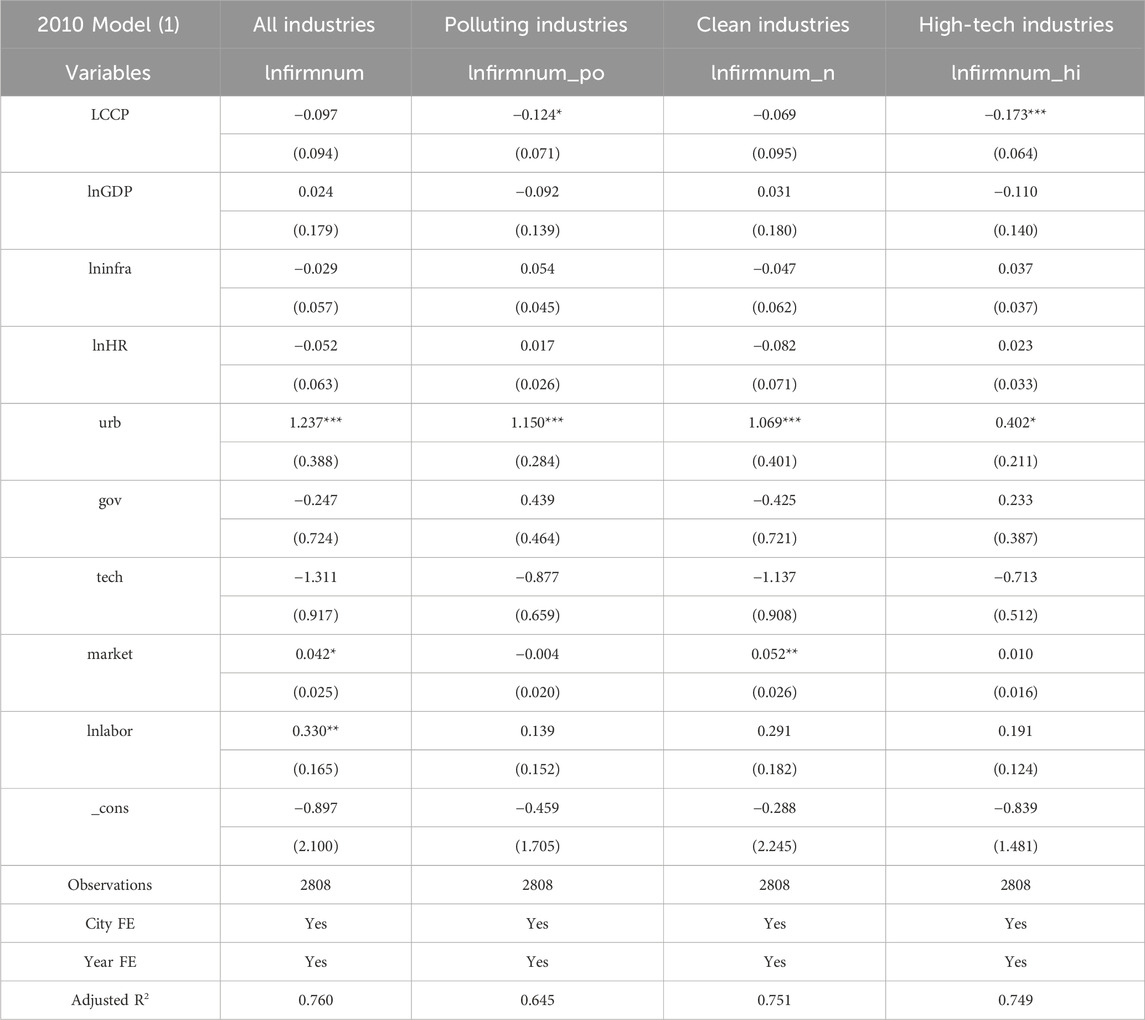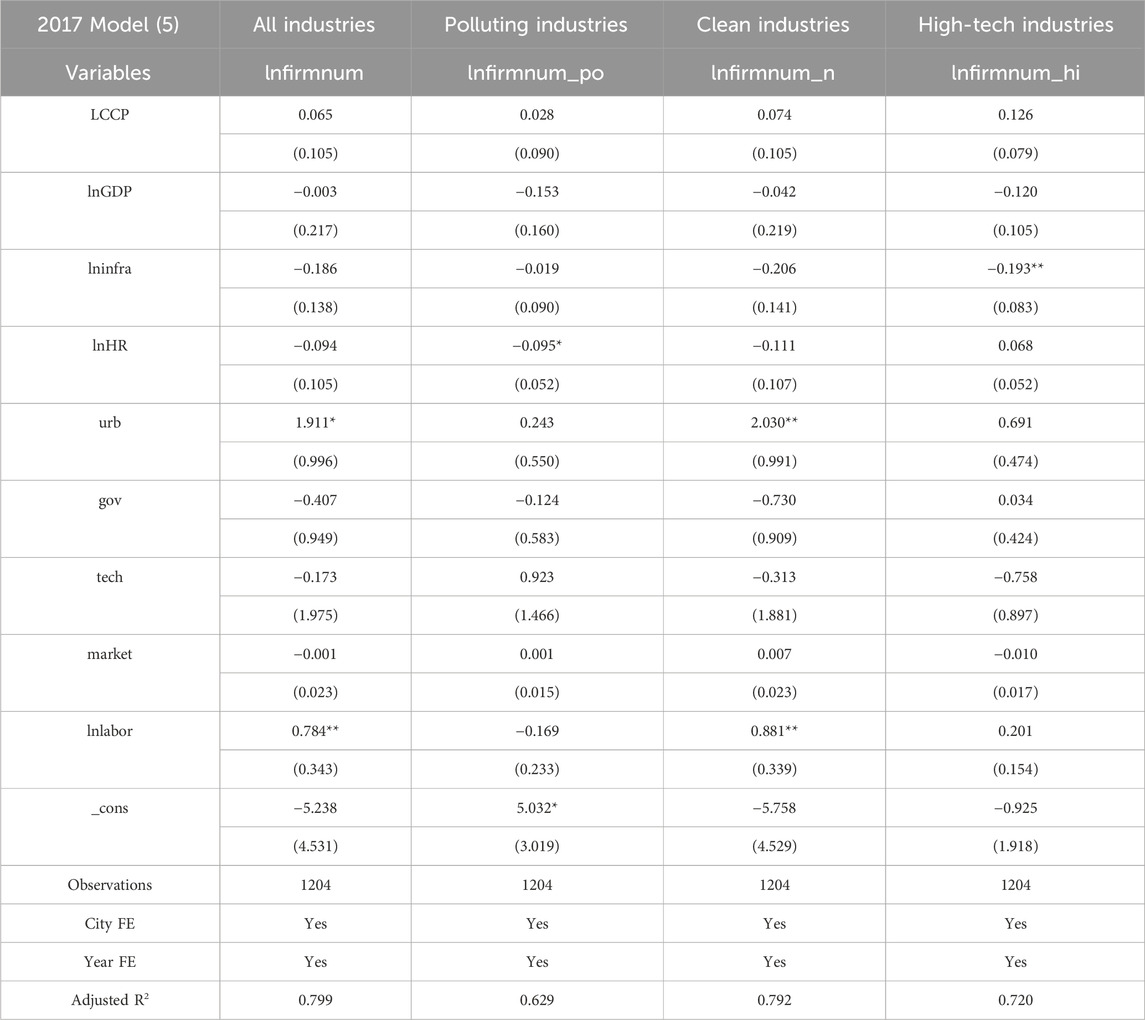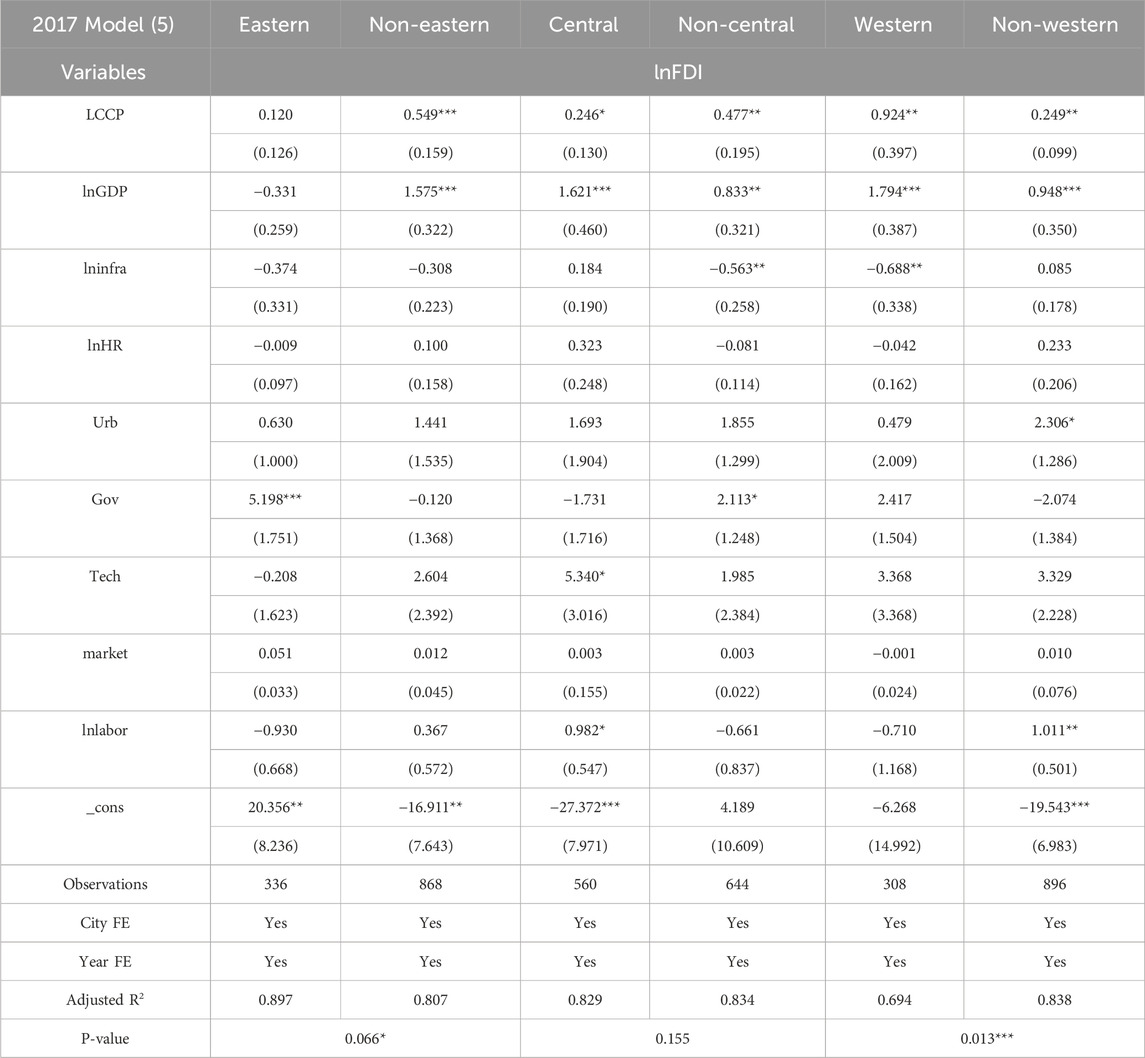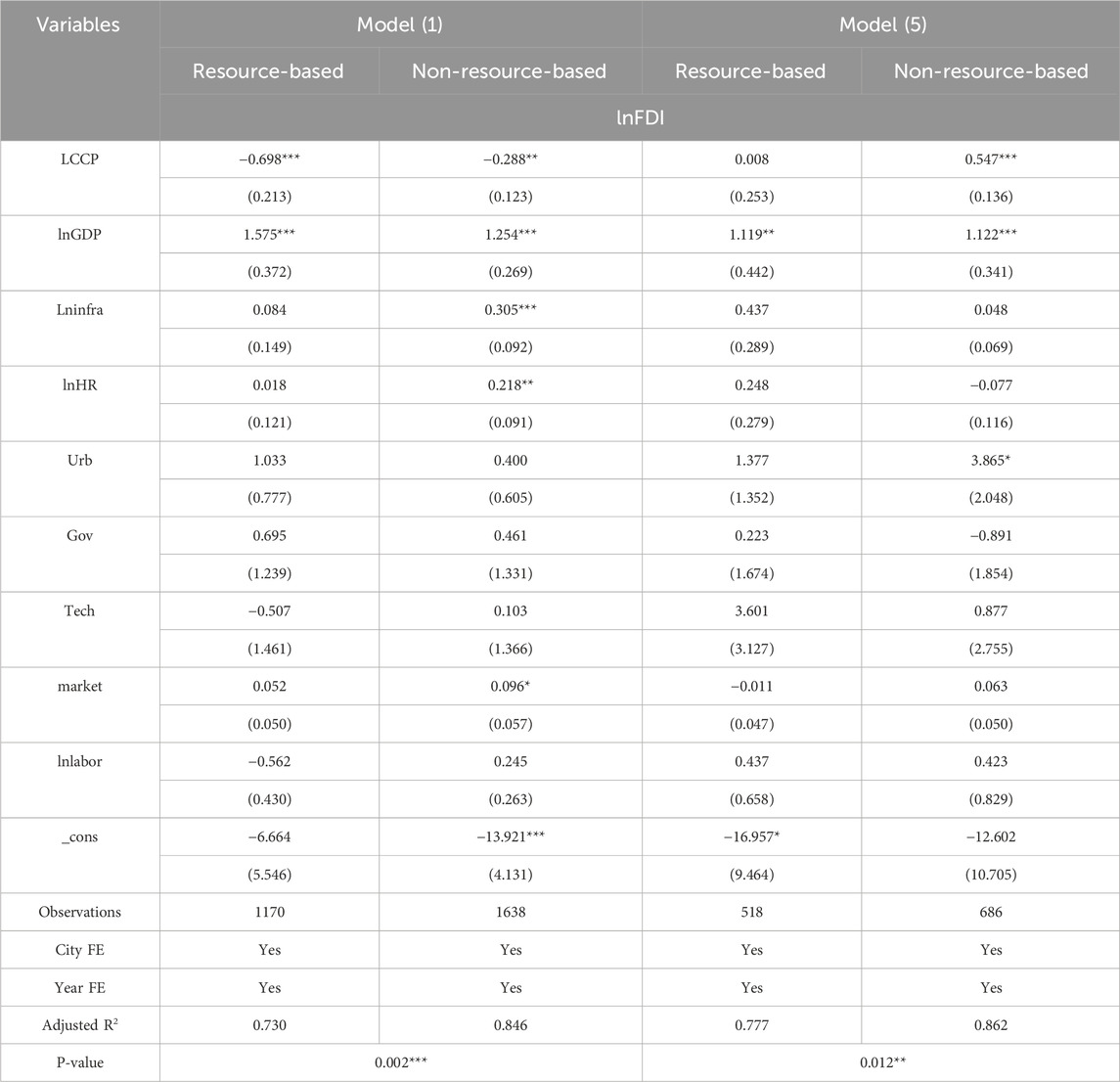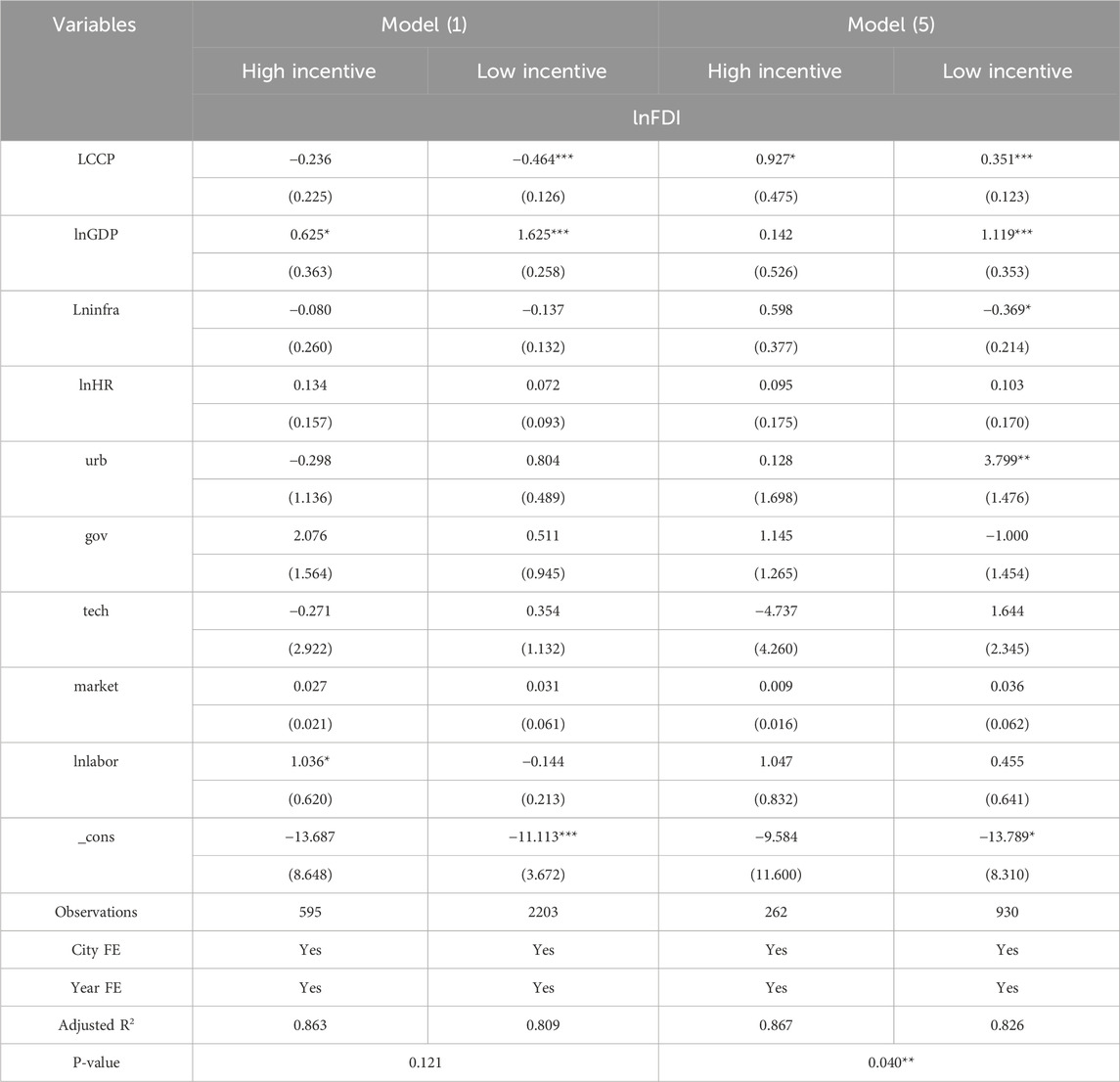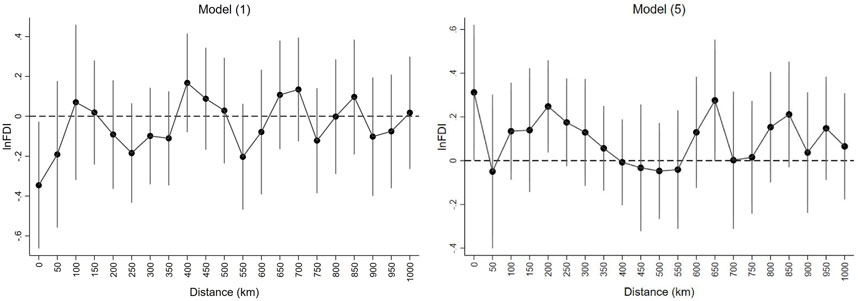- 1School of Economics and Management, Taiyuan University of Technology, Taiyuan, China
- 2Shanxi Key Laboratory of Data Element Innovation and Economic Decision Analysis, Taiyuan University of Technology, Taiyuan, China
Indroduction: This study investigates the impact of China’s Low-Carbon City Pilot (LCCP) policy, characterized by its flexible and “weakly binding” nature, on Foreign Direct Investment (FDI) patterns.
Methods: We specifically focus on the heterogeneous effects of this flexible environmental regulation over time and its micro-level mechanisms. Employing a quasi-natural experiment framework and a Difference-in-Differences (DID) methodology, we analyze city-level panel data and micro-level enterprise registration data from 2007–2019.
Results: Findings reveal significant temporal heterogeneity: the first LCCP batch (initiated in 2010) suppressed FDI, while the third batch (2017) promoted it. Mechanistically, the initial batch deterred the entry of both polluting and high-tech foreign firms, whereas the later batch encouraged investment expansion by existing foreign invested enterprises. Furthermore, the policy’s effects are influenced by FDI saturation, resource endowment, and the rigor of policy implementation. Contrary to the Pollution Haven Hypothesis, no significant regional pollution transfer effect was observed; instead, the third batch stimulated positive FDI spillovers in nearby regions (150–200 km).
Discussion: These results provide empirical evidence on how flexible environmental policies shape FDI, offering insights for balancing economic growth and sustainability.
1 Introduction
The global imperative to mitigate climate change presents a formidable challenge, particularly for developing nations striving to balance environmental sustainability with economic growth imperatives. Foreign Direct Investment (FDI) remains a crucial catalyst for development, yet its sensitivity to environmental regulations creates a significant policy dilemma, a phenomenon known as the “Pollution Haven Hypothesis”. Does the implementation of carbon reduction policies inevitably deter essential FDI inflows, thereby hindering growth? Or can thoughtfully designed environmental governance foster greener development pathways without compromising, or perhaps even enhancing, investment attractiveness? Addressing this tension is pivotal for crafting effective climate strategies and achieving sustainable development goals globally.
China, as the world’s largest developing economy and one of the largest recipients of foreign direct investment, confronts substantial environmental pressures alongside rapid economic growth, offering a unique context for investigating this policy nexus. In response, China has initiated various environmental programs, among which the “Low-Carbon City Pilot” (LCCP) policy, launched in three batches (2010, 2012, and 2017) and now covering 87 cities and regions (Gao et al., 2022), stands out as a significant institutional innovation. Distinct from many previous environmental regulations, the LCCP is characterized by its “weakly binding” nature, often employing non-mandatory, guidance-oriented language like “guide”, “encourage”, and “promote”, and granting considerable autonomy to local governments for policy exploration and implementation. This unique policy design raises fundamental questions about its efficacy and economic consequences.
While the extensive literature examining the relationship between environmental regulation and FDI offers valuable insights, it predominantly focuses on the impacts of more stringent policies, such as the US Clean Air Act Amendments (Hanna, 2010), emission tax rates (Yan and Li, 2023), and COD (Chemical Oxygen Demand) reduction mandates (Yang et al., 2018). However, the impact of weakly binding policies like the LCCP on FDI remains inconclusive. Does the lack of stringent enforcement render these policies ineffective, or does their inherent flexibility allow for a more nuanced balancing of economic and environmental objectives, potentially yielding different outcomes for FDI? Moreover, previous studies often employ two-way fixed effects difference-in-differences (TWFE-DID) models, which assume homogeneous treatment effects across all pilot cities and time periods. This approach may overlook the potential heterogeneity in policy effects across different batches of pilot cities and over time. Recent research has indeed found significant heterogeneity in carbon reduction effects across different batches of LCCP policies (Lyu et al., 2023), highlighting the importance of considering these variations. This ambiguity underscores the necessity and timeliness of the present study.
Therefore, this study aims to empirically evaluate the impact of China’s unique weakly binding LCCP policy on the patterns and evolution of FDI. Leveraging the phased implementation of the LCCP across three distinct batches as a quasi-natural experiment, we employ a difference-in-differences (DID) methodology, augmented by a suite of robustness checks. Our analysis draws upon both prefecture-level city data and micro-level enterprise registration data from 2007 to 2019 to provide a comprehensive assessment of the policy’s causal effects, underlying mechanisms, and potential heterogeneity.
This research contributes to the existing literature and policy discourse in several key ways. First, we provide novel empirical evidence on the effectiveness and economic implications of non-mandatory governance tools, moving beyond the traditional focus on stringent regulations. Second, our analysis reveals significant temporal heterogeneity in policy effects across different LCCP batches, challenging monolithic views of environmental policy impacts and highlighting the importance of considering policy evolution and design specifics. Third, the use of micro-data allows for a nuanced examination of the mechanisms, differentiating between effects on polluting, clean, and high-tech industries foreign-invested enterprises (FIEs) and shedding light on the validity of the Pollution Haven Hypotheses within this specific context.
The remainder of this paper is organized as follows illustrated in Figure 1: Section 2 reviews the literature and develops hypotheses. Section 3 details the empirical methodology and data description. Section 4 presents the empirical results and robustness checks. Section 5 performs the mechanism analysis. Section 6 conducts the heterogeneity analysis. Section 7 further examines the “Pollution Haven” hypothesis. Section 8 concludes.
2 Literature review and hypotheses
2.1 Environmental regulatory policies and FDI
The implementation mechanism of LCCP policies has continuously evolved and improved. It transitioned from an initial exploratory nature to gradually establishing explicit carbon peaking targets and total quantity control. The focus has deepened from basic elements like comprehensive planning formulation, the establishment of low-carbon industrial systems, and statistical frameworks, to the development of robust target performance evaluation systems. The requirements for innovation have expanded from solely technological innovation to multi-dimensional innovation, encompassing models, institutions, technologies, and engineering approaches. Furthermore, the demands on management mechanisms have become progressively refined, moving from simple data statistical management to the establishment of complete organizational structures and coordination mechanisms. The initial target responsibility system has evolved into a more stringent assessment and evaluation system. Later policy documents have clearly defined specific timelines and phased targets, reflecting a significant strengthening of policy enforcement and the continuous improvement of accountability mechanisms. The LCCP policy differs from other environmental regulatory policies in several key aspects:
2.1.1 Scope
The LCCP policy is primarily implemented at the prefecture-level city scale, encompassing entire urban areas (Gao et al., 2022). This comprehensive approach contrasts with other carbon reduction policies that target specific industries or are limited to particular trading markets, such as carbon emission trading policies (Shao et al., 2022; Satoğlu and Salmon, 2024), environmental or emission taxes (Yan and Li, 2023), or regulations focused on specific pollutants like SO2 (Yang et al., 2018). The LCCP policy involves multiple sectors including energy, industry, construction, and transportation, constituting a systemic urban development policy.
2.1.2 Governance
The LCCP policy is characterized by “weak constraints”, granting local governments greater autonomy and space for innovation (Tie et al., 2020). Led by local authorities, this pilot emphasizes the principal role of local governments in low-carbon development, distinguishing it from top-down, mandatory emission reduction policies like total energy consumption control, China’s Two Control Zone policy for air pollution, the Pollution Quantity Control Policy setting reduction mandates for local governments (Yang et al., 2018), or the US Clean Air Act Amendments (Hanna, 2010).
2.1.3 Incentive structure
The LCCP policy features “weak incentives”, emphasizing local exploration and innovation to achieve policy objectives rather than relying on direct intervention or economic incentives from the central government (Yang and Peng, 2022). This approach contrasts sharply with subsidy policies that offer explicit economic incentives, such as technology support policies providing R&D funding or tax credits (Satoğlu and Salmon, 2024), financial incentives like feed-in tariffs and net metering (Wiredu et al., 2025), or specific green investment incentives including reduced corporate tax, investment allowances, and tax credits (Demena and Afesorgbor, 2020), as well as financing mechanisms like green bonds (Ayo-Balogun et al., 2025). Consequently, the LCCP policy thereby showcases a greater capacity for institutional innovation compared to other carbon reduction policies (Song et al., 2020). The “National Low-Carbon City Pilot Work Progress Evaluation Report” notably includes “innovative initiatives” as a key indicator in its evaluation system.
These distinctive features of the LCCP policy have motivated researchers to assess the policy’s impacts from various perspectives, contributing to a growing body of literature on urban sustainability and environmental governance in developing contexts.
The LCCP programs have multifaceted impacts on regional economic and social development. Existing literature has demonstrated, from both macro and micro perspectives that the LCCP policy promotes urban innovation (Ma et al., 2021; Zou et al., 2022; Yang, 2023; Pan and Zhao, 2024). Zhao et al. (2024) found that the LCCP policy drives industrial structure upgrading. Wang L. et al. (2023) research indicates that the LCCP policy can significantly improve energy efficiency.
Studies evaluating LCCP policy’s impact on FDI show varied results. Zhao and Wang (2021), examining only the second batch, found the policy promoted FDI via industrial upgrading. Pan et al. (2023) and Ni et al. (2022), covering all three batches, reached different conclusions on FDI quantity: Pan et al. found it attracted FDI through cost reduction and innovation, while Ni et al. found it reduced FDI quantity but improved its quality, especially in innovative cities. A commonality is the reliance on macro-level proxies (e.g., city-level spending, industrial structure) for mechanism analysis. While indicating roles for innovation and structural change, this macro-level approach risks conflating the responses of domestic Chinese enterprises with those of FIEs. Consequently, it may lead to an inaccurate identification of the precise mechanisms through which the LCCP policy influences firm-level FDI decisions.
Regarding the relationship between environmental regulation and FDI, there are two main viewpoints in the academic community: first, the “Pollution Haven Hypothesis”, which posits that stringent environmental regulations lead FDI to shift to regions with lower environmental standards (Eskeland and Harrison, 2003); second, the “Pollution Halo Hypothesis”, which argues that FDI enhances the host country’s environmental quality through technology spillover effects (Cole et al., 2008). Cole and Elliott (2005) through cross-national studies of developed and developing countries, found that the impact of environmental regulation on FDI exhibits significant industry heterogeneity. The “Pollution Haven Effect” is more likely to occur in capital-intensive polluting industries. While literature sharing the same theme as this paper interpret their findings in light of the Pollution Haven, they do not conduct direct empirical tests of these theories.
To sum up, the impact of the LCCP policy on FDI has not yet reached a systematic conclusion. Specifically, as an environmental regulation policy characterized by “weak incentives and weak constraints”, the LCCP policy grants policy implementers greater flexibility in formulating policies and may adopt strategies that differ from those of other environmental policies (Chen et al., 2023), which may inherently introduce a certain degree of policy uncertainty for market participants (Rehman et al., 2023). The shortcomings of existing research lie in neglecting this unique nature, relying on TWFE-DID while overlooking policy heterogeneity across different batches, obtaining inconsistent results from macro proxy variable analysis of policy transmission mechanisms, and failing to directly test the validity of the “Pollution Haven” hypothesis at the FDI level. It remains an important area of research to investigate whether this affects foreign investment decisions and through what mechanisms it influences FDI inflows. This study overcomes these research deficiencies by focusing on weak binding, considering the effects of different policy batches, using micro-level data, and examining spatial spillover effects.
2.2 Theoretical analysis and hypotheses
This study explores the transmission mechanisms of the LCCP policy from the perspectives of the Broad Meaning of Industry Transfer Theory, the Porter Hypothesis, and the Pollution Haven Hypothesis. Based on the Broad Meaning of Industry Transfer Theory, industrial transfers between regions in China are primarily characterized by the relocation of low-end industries from the more economically developed eastern regions to the central and western regions, while high-end industries remain concentrated in the eastern areas, exhibiting varying levels of foreign investment saturation (Shi et al., 2019; Ang, 2018). Building on this transfer pathway and incorporating regional heterogeneity, the study analyzes the policy impacts. The Porter Hypothesis posits that appropriately designed environmental regulations can stimulate corporate innovation, not only offsetting the costs associated with environmental regulations but also enhancing the competitiveness and market performance of enterprises (Porter and Linde, 1995). On the other hand, the Pollution Haven Hypothesis suggests that multinational corporations tend to relocate pollution-intensive industries to countries or regions with more lenient environmental regulations to reduce environmental compliance costs (Copeland and Taylor, 1994).
Low-carbon city pilot policies are exploratory policies with weak constraints, differing from other environmental regulation policies with explicit goals. At the national level, no specific hard targets, such as carbon emission peak dates or industry-specific emission standards, are set for the pilot cities. Instead, these policies delegate decision-making authority to the respective pilot governments, allowing them to advance low-carbon initiatives based on local conditions (Gao et al., 2022). This approach follows the “the center decides and the local pays” model (Fan, 2014), wherein different cities may not necessarily adopt mandatory emission reduction measures during implementation. Pilot cities, balancing considerations of economic growth and environmental protection, may make different decisions—either continuing economic development or strengthening environmental regulations—thereby influencing FDI.
Furthermore, the designation of low-carbon city pilots as “exemplars” embodies the central government’s recognition of the pilot cities’ efforts in environmental governance, granting them significant environmental legitimacy advantages and reducing pressure in environmental performance assessments (Xu and Li, 2022; Zheng and Guo, 2022). Wang Z. et al. (2023) mentioned that there is an obvious spatial correlation among interstate carbon emissions. Consequently, local governments might retain high-pollution enterprises or even attract pollution-intensive foreign investment.
The temporal span of low-carbon city pilot policies is extensive, and later batches of pilot cities possess certain latecomer advantages. They can leverage the successful experiences of earlier low-carbon cities (Zhang and Zhu, 2018), rapidly accumulate green development technologies and expertise, shift the focus of early policies, and improve the inflow of local FDI.
Based on this, the following hypothesis is proposed:
Hypothesis H1:. The impact of the LCCP policies on FDI in pilot cities varies across different batches, indicating temporal heterogeneity in the policies.
Most LCCP policies establish total carbon emission control targets and carbon peak requirements for cities. These policies involve the formation of specialized leadership teams by local governments to coordinate and oversee the implementation, delegating emission reduction tasks to enterprises and various departments (Zhuang, 2020). The government guides and regulates corporate production and operational activities through measures such as developing low-carbon development plans, formulating supporting policies, and establishing a system of accountability for targets. These policy measures influence the costs associated with enterprises’ production and operations, directly affecting the extent of policy support they receive and their development potential (Ramanathan et al., 2017). Just as the Pollution Haven Hypothesis, the LCCP policy can influence the flow of FDI. In a system where GDP is the primary evaluation metric (Deng, Y. et al., 2024), some regions might choose to lower environmental standards to attract these enterprises, thereby creating localized “pollution havens”. This tendency is also observed among pollution-intensive FIEs, which prefer to transfer their production activities to areas with relatively lax environmental regulations, potentially relocating either abroad or to non-pilot low-carbon cities. Namely, this may impede the entry of pollution-intensive foreign enterprises into pilot regions.
However, the impact of FIEs relocating to non-pilot areas is more complex. If the Pollution Haven Hypothesis holds true between regions, the relocation caused by the LCCP policy could result in significant sample selection bias, thereby affecting the net effects derived in this study. Therefore, we propose two competing hypotheses to empirically test whether the LCCP policy indeed generates such relocation and bias:
Hypothesis H2a:. The LCCP policy creates “pollution havens”, attracting pollution-intensive foreign enterprises to China.
Hypothesis H2b:. The LCCP policy does not create “pollution havens”, and thus does not attract pollution-intensive foreign enterprises to China.
Furthermore, from the perspectives of the Broad Industry Transfer Theory and the Porter Hypothesis, the displacement or obstruction of entry reduces the intensity of FDI in a region, thereby providing more investment opportunities that attract green and clean FDI. As mentioned above, low-carbon cities can improve energy efficiency (Wang Z. et al., 2023) and promote industrial structure upgrading (Zhao et al., 2024). This green transformation and innovative environment may attract more FDI with green technology advantages while simultaneously potentially inhibiting FDI that is technologically lagging or has weaker innovation capabilities, thereby affecting the cost structure of enterprises’ production. The potential cost advantages may attract more FDI focused on environmental protection technologies and clean production, but they may also increase overall production costs. In conjunction with the Porter Hypothesis, it can be inferred that foreign enterprises not yet operating in China may choose to establish themselves in other countries, while those already established in China (FIEs) may opt to increase their R&D investments to bridge the gap. Based on the above analysis, the following hypotheses are proposed:
Hypothesis H3:. The LCCP policy inhibits FDI by obstructing the entry of foreign enterprises into pilot regions, particularly by restraining pollution-intensive foreign enterprises.
Hypothesis H4:. The LCCP policy promotes FDI by attracting clean foreign enterprises to enter pilot regions and by encouraging existing FIEs to expand their investments.
These hypotheses are synthesized in Figure 2, which illustrates the conceptual framework linking LCCP mechanisms to FDI outcomes.
3 Empirical methods and data description
3.1 DID model
To identify the impact of the LCCP policy on FDI, this study treats LCCP policy as a quasi-natural experiment. Referencing the research of Cheng et al. (2019) and Wei et al. (2023) this paper employs the difference-in-differences (DID) method and controls for city and year fixed effects. Subsequently, a series of robustness checks are conducted, and potential confounding policies are excluded to alleviate sample selection bias, thereby enhancing the reliability and accuracy of policy effect evaluations.
In the regression model,
Following Clarke’s (2017) approach, we specify the following model based on Equation 1 to test Hypothesis 2a:
Equation 2 relaxes the Stable Unit Treatment Value Assumption (SUTVA) by introducing a neighborhood treatment group, requiring only partial adherence to the SUTVA assumption. This approach allows for the estimation of both Treatment Effects and Close to Treatment Effects. Building upon Equation 1, a new set of control variables
3.2 Data and variables
3.2.1 Explained variable
The explained variable in this study is the total actual foreign direct investment in the region (lnFDIit), which measures the impact of the policy at an aggregate level. The natural logarithm of the total actual FDI at the prefecture-level city is utilized to minimize multicollinearity and heteroscedasticity within the model as much as possible.
3.2.2 Explanatory variables
LCCPit is the interaction term between the time dummy variable and the region dummy variable. Based on the three batches of “Low-Carbon City Pilot Lists” announced by the National Development and Reform Commission in 2010, 2012, and 2017, the time dummy variable is assigned a value of 1 for the year of approval and the subsequent years, and 0 for the years prior to approval. Since the low-carbon city pilot projects were implemented in three separate batches, for cities selected in multiple batches, the time definition is based on the earliest implementation time. If a province is approved as a low-carbon pilot region, then all cities within that province are subjected to the LCCP. If a prefecture-level city is designated as a LCCP, then the region dummy variable is set to 1; otherwise, it is set to 0.
3.2.3 Control variables
Considering that the selection of LCCPs is not entirely random and that other city-level factors may have potential impacts on FDI, following the approaches of Zhang and Wang (2023) and Shao et al. (2022), this paper selects a series of control variables. These include: Economic Development Level (lnGDP), measured by the natural logarithm of per capita GDP, reflects the region’s economic strength and living standards. Infrastructure Construction Level (lninfra), calculated as the natural logarithm of per capita road area in prefecture-level cities, indicates the quality of urban infrastructure. Human Capital (lnHR), represented by the natural logarithm of students per 10,000 individuals, captures the region’s educational attainment and talent pool. Urbanization Level (urb), the ratio of urban permanent population to total permanent population, signifies the degree of urbanization and demographic structure. Government Intervention (gov), expressed as the proportion of general government expenditure to regional GDP, quantifies the extent of government involvement in the economy. Technological Innovation (tech), measured by the share of science and technology expenditure in general government expenditure, indicates regional innovation capacity. Marketization Level (market), calculated as the ratio of total urban private and individual employed personnel to the year-end number of employed personnel in urban work units, reflects the development of the private sector. Labor Costs (lnlabor), represented by the natural logarithm of average urban employee wages, provides insight into regional labor market conditions.
3.2.4 Data sources
This study selects panel data from 265 prefecture-level cities spanning the years 2007 to 2019. The period from 2007 to 2019 was chosen for three primary reasons: first, the COVID-19 pandemic in 2020 significantly altered various economic indicators, resulting in substantial differences compared to the pre-2020 period; second, the gradual nationwide promotion of successful pilot experiences in 2020 contradicts the fundamental assumptions of the DID methodology; third, FDI data prior to 2007 are severely lacking.
Due to severe data deficiencies, the research excludes regions such as Hong Kong, Macau, Taiwan, and Tibet, as well as specific prefecture-level cities in provinces including Gansu, Guizhou, Jilin, Ningxia, Guangdong, Hubei, Hainan, Yunnan, Qinghai, and Xinjiang. Additionally, the prefecture-level cities of Chaohu in Anhui and Laiwu in Shandong were excluded following their administrative dissolution. For cities with minor data gaps in specific years or variables, interpolation methods were employed to complete the missing values.
The data sources for this study include the National Bureau of Statistics, the “China City Statistical Yearbook”, and the State Administration for Industry and Commerce (SAIC) of China. Table 1 presents the descriptive statistics of the observed variables, including sample size, mean, standard deviation, minimum value, and maximum value.
4 Empirical results
4.1 Baseline regression
Drawing inspiration from the concept of “group-time average treatment effects” where groups (g) are defined by the timing of initial treatment (Callaway and Sant’Anna, 2021), this section first examines the significance of the pilot effects and tests for heterogeneity across different LCCP batches using regressions based on Equation 1. ① For the first batch (g = 2010), we isolate its impact by either excluding second and third batch cities from the full sample (Model 1) or by focusing on the initial years 2007–2011 (Model 2). ② For the second batch (g = 2012), we estimate its effect by restricting the sample to 2007–2016 and removing first batch cities (Model 3), or by using the full sample while excluding first and third batch cities (Model 4). ③ Likewise, for the third batch (g = 2017), we estimate its impact by excluding the first two batches from the full sample (Model 5) or by using a restricted 2013–2019 sample, again excluding the earlier batches (Model 6). Beyond these individual batch assessments, we also utilize a multi-period DID model to estimate the average treatment effects considering the staggered rollout across all batches (Models 7, 8, 9). Table 2, columns (1) through (9), presents the estimation results from all these approaches.
Based on the regression results, the coefficients of LCCP in Models (1), (7) and (9) are all significantly negative. Models (1) and (2) indicate that the first batch of the LCCP policies does not have a significant impact on FDI in the short term. However, Models (3) and (4) show that the impact of the second batch of pilot policies on FDI is not statistically significant. Conversely, according to Columns (5) and (6), the third batch of pilot policies significantly promotes FDI. Model (9) shows that, overall, the LCCP policies exert a significant negative effect on FDI. Notably, the absolute value of the LCCP coefficient in this model is the smallest among all models showing a negative effect, which indirectly reflects the existence of the third batch’s positive impact. These findings suggest that the three batches of pilot policies exhibit strong temporal heterogeneity, thereby supporting Hypothesis H1.
Likewise, Lyu et al. (2023) found that the effects of the third batch of policies are inferior to those of the first two batches and may even lead to an increase in carbon emissions. This discrepancy may be attributed to the fact that the first batch of pilots was selected through a non-public central selection process, prioritizing cities with better foundational conditions. In contrast, the second and third batches gradually expanded to include second-, third-, and fourth-tier prefecture-level cities, with more comprehensive considerations (Zhuang, 2020). The latter two batches of pilot cities are less attractive to foreign investment compared to the first batch, resulting in a smaller impact on local FDI. Furthermore, the third batch of pilots may incorporated experiences from previous batches and adopted context-specific governance measures.
4.2 Robustness tests
4.2.1 Parallel trends test and baseline model selection
To determine whether the changes in FDI is attributable to the implementation of the pilot policies, a more detailed examination is necessary. Drawing on the approach of Beck et al. (2010), this study employs an event study methodology to test the pre-treatment parallel trends and the dynamic effects of the policies. The model is specified as follows:
In Equation 3,
As shown in Figure 3, which presents the parallel trend test results obtained from Equation 3, before the announcement of the pilot list, there were no pre-existing differences in FDI between pilot cities and non-pilot cities for models (1), (5), (6), (7), and (9), satisfying the parallel trends assumption of the DID model.
Examining the models that passed the parallel trends test: Model (1), corresponding to the first batch of pilots, shows partially significant negative and small estimated coefficients for the first 4 years after the pilot list announcement. From the fifth year onwards, the suppressive effect on FDI intensifies, demonstrating a certain lag. Starting from the seventh year after the first batch of pilots, the suppressive effect gradually weakens, showing a U-shaped pattern over time. Models (5) and (6), corresponding to the third batch of pilots, differ from the first batch in that the policy not only promoted FDI but also had a rapid response. Models (7) and (9) employ the staggered DID approach, providing additional support for the robustness of our findings. However, the coefficients for the pre- and post-periods may be slightly affected by the second batch of pilots, showing minor fluctuations but passing the parallel trends test and remaining significant in the post-period. This further supports the notion that using a staggered difference-in-differences model to study the three batches of pilot policies may overlook the heterogeneity of policies from different batches (Hypothesis H1).
In summary, the pilot policies from different batches exhibit characteristics of heterogeneity and lag, echoing the research findings of Lyu et al. (2023). Considering the impact of pre-treatment fluctuations, this paper uses Model (1) corresponding to the first batch of pilot cities (2010) and Model (5) corresponding to the third batch of pilot cities (2017) as baseline regressions, and conducts a series of robustness tests, mechanism analyses, and heterogeneity analyses.
4.2.2 Sensitivity analysis of the parallel trends assumption
However, pre-treatment trend tests cannot be considered as definitive empirical evidence for the parallel trends assumption (Roth et al., 2023). Drawing on the parallel trends sensitivity analysis method proposed by Rambachan and Roth (2023), we examine the impact of violations of the parallel trends assumption on event study point estimates and confidence intervals through relative deviation degree restrictions. Following the approach of Biasi and Sarsons (2022), we set the maximum deviation degree Mbar = 1 × standard error to test the sensitivity of the treatment effect to parallel trends after the implementation of the LCCP policy.
Figures 4, 5 present sensitivity tests for the periods where the policy effects are significantly different from zero after policy implementation in Models (1) and (5). The test results show that the confidence intervals under deviation degree restrictions do not include 0. This implies that even if there are some deviations from parallel trends, the LCCP policy still significantly affects FDI.
4.2.3 Heterogeneous treatment effects test
Moreover, Goodman-Bacon (2021) points out that even when the parallel trends assumption is satisfied, the staggered DID method may still face a “bad control group” problem due to inconsistent treatment timings. de Chaisemartin and D’Haultfœuille (2020) emphasize that the heterogeneity of treatment effects is an important cause of bias in two-way fixed effects models, which may still exist in research scenarios where the same policy is implemented at the same time.
To address this issue, we employ the DID estimator for multiple periods and groups (DIDM) proposed by de Chaisemartin and D’Haultfœuille to diagnose potential heterogeneous treatment effects in the baseline regression, and obtain the event study graph (Figure 6). The results show that the DIDM results are largely consistent with the baseline regression. In terms of weighted average treatment effects, the policy effect for Model (1) is −0.557 (t-value −5.439), and for Model (5) is 0.430 (t-value 2.707), confirming the robustness of the research conclusions.
4.2.4 Application of synthetic difference-in-differences
The synthetic difference-in-differences (SDID) method proposed by Arkhangelsky et al. (2021) is employed in this study. This method introduces appropriate individual and time weights, eliminating the need for strict parallel trends assumptions. The SDID model is used to estimate the average treatment effect of the LCCP policy, with results reported in Table 3. The table shows that the average treatment effect estimated by the SDID model is consistent with the conclusions from the baseline regression, further verifying the robustness of the research results.
4.2.5 Excluding interference from other policies
To further eliminate interference from other policies and more cleanly identify the policy impact effect of low-carbon city construction on FDI, this paper, through a review of policy documents, found that the list of Key Regions for Air Pollution Prevention and Control (KRAPC) outlined in the “Announcement on Implementing Special Emission Limits for Air Pollutants” published by the Ministry of Ecology and Environment in 2013 and the “Three-Year Action Plan for Winning the Blue Sky Defense Battle” published in 2018, the Free Trade Zones (FTZ) gradually established since 2013, and the Pilot Zones for Green Finance Reform and Innovation (PZGFRI) implemented progressively since 2017 might produce effects similar to the LCCP policy. Therefore, we incorporate dummy variables for KRAPC, FTZ, and PZGFRI into the baseline regression model to mitigate potential interference from these concurrent policies when estimating the LCCP effect. Based on Equation 1, the following equation is established:
In Equation 4,
Table 4 reports the corresponding estimation results. It can be observed that the core explanatory variable LCCP in models (1) and (5) remains significant. Therefore, the impact of the LCCP policy on FDI is indeed caused by this policy, rather than others.
4.2.6 Placebo tests
The selection of the LCCP policy is not entirely random. To rule out potential confounding factors and verify the reliability of the baseline regression results, following Chen et al.’s (2025) approach, this paper further conducts in-time placebo tests, in-space placebo tests, and mixed placebo tests.
The treatment time for the 2010 treatment group is moved 1 to 2 periods earlier, and the treatment time for the 2017 treatment group is moved 1 to 3 periods earlier for regression analysis in the in-time placebo tests. The results are shown in Figure 7. The P-values of all placebo effects are greater than 0.1, and the 95% confidence intervals of all placebo effects include 0. Therefore, the in-time placebo test is passed.
The core explanatory variable, LCCP, is randomly sampled 1,000 times without replacement and regressed using the DID method, resulting in Figure 8. From the regression distribution graph, it can be seen that the estimation results of the virtual samples are normally distributed around the value of 0. The estimated coefficient of the baseline regression for the 2010 group (Model 1) falls completely outside the distribution of the virtual sample results, while the estimated coefficient for the 2017 group falls in the right tail of the distribution. This means that the baseline regression results of this paper have passed the placebo test.
For the mixed placebo tests (Figure 9), the estimated coefficients of randomly assigned virtual pilot cities and virtual policy time points basically show a normal distribution centered at 0. The real regression coefficients are all located in the tail of the placebo effect distribution, thus passing the placebo test.
4.2.7 Replacing the explained variable
To ensure the robustness of the baseline results, the per capita actually utilized foreign direct investment (lnperFDI) is used as the alternative explained variable in Equation 1. As can be seen from the regression results in Table 5, the coefficients of LCCP are all significant at the 1% level. This corroborates the robustness of the above baseline analysis.
4.2.8 Including time trends
The selection of cities for the LCCP policy may have considered certain specific criteria. If these criteria could also influence economic development trends, then the differences in FDI between pilot and non-pilot regions after policy implementation might be due to these selection criteria, potentially biasing the estimation results of Equation 1. To address this potential issue, following the approach of Huang and Yi (2023), we further control for the interaction terms between the pilot selection variables and the first, second, and third order time variables based on Equation 1. The regression results are shown in Table 5, where the coefficient of LCCP remains significant.
5 Mechanism analysis
Given the significant impact of LCCP on FDI, how would foreign-invested enterprises (FIEs) respond at the micro level? Therefore, following the approach of Tian and Xu (2022), we obtained data on the establishment of FIEs from the State Administration for Industry and Commerce (SAIC) of China. In line with the National Bureau of Statistics’ statistical criteria, we use the number of newly established FIEs to examine the impact of the pilot policy on FIEs in different industries. FIEs include Chinese-foreign equity joint ventures, Chinese-foreign cooperative joint ventures, wholly foreign-owned enterprises, and foreign-invested joint stock limited companies.
5.1 Industry classification of FIEs
5.1.1 Polluting industries
Based on industry characteristics and environmental impact, and according to the “National Economic Industry Classification” (GB/T 4754-2017), enterprises are categorized into polluting industries and non-polluting industries. Specifically, polluting industries mainly include the following categories: chemical manufacturing, metal smelting and processing, mineral extraction, textile dyeing and printing, paper and paper products manufacturing, building materials manufacturing, energy production and supply, and other high-pollution industries (Shi et al., 2019). Industries other than those listed above are classified as non-polluting industries.
5.1.2 Clean industries and high-tech industries
Within non-polluting industries, following the approach of Lyu and Yu (2020), we further distinguish between non-polluting non-high-tech industries and high-tech industries, and considers non-polluting non-high-tech industries as clean industries. Based on the “Classification of High-tech Industries (Manufacturing) (2017)” issued by the National Bureau of Statistics, high-tech industries are identified as follows: pharmaceutical manufacturing, aerospace vehicle and equipment manufacturing, electronic and telecommunications equipment manufacturing, computer and office equipment manufacturing, and medical equipment and instrument manufacturing industry. However, as the database does not contain information on electronic chemicals manufacturing industry, this category is not considered in our analysis.
5.1.3 Model specification
Based on Equation 1, we replace the explained variable with the logarithm of the number of newly established FIEs in city
5.2 The first batch: hindering the entry of polluting and high-tech FIEs
According to the regression results (Table 6), overall, the first batch of the LCCP policy did not significantly deter FIEs from entering pilot regions. A possible reason is that the policy primarily focused on “carbon reduction” and “decarbonization” measures in high-carbon industries. Therefore, without distinguishing industry carbon attributes, the pilot policy had limited impact on foreign enterprise decision-making at the aggregate level.
Further examining the mechanism by differentiating industries, using the number of newly established enterprises in polluting industries (
5.3 The third batch: investment expansion by existing FIEs
The regression results in Table 7 indicate that the third batch of pilot policies did not significantly promote the entry of FIEs into China, with results remaining insignificant across different industries. The insignificance of the coefficient for the number of newly established FIEs in polluting industries (
5.4 Comprehensive mechanism analysis
A comprehensive analysis of the effects of two batches of LCCP policies reveals that these policies have played a significant role in promoting the structural adjustment of FDI. Empirical results indicate that the pilot policies have had a deterrent effect on polluting and high-tech foreign enterprises entering China, reflecting the selective impact of the policies on FDI quality. Enterprises that choose to continue investing in China demonstrate a stronger willingness to comply and innovate, rather than adopting a “beggar-thy-neighbor” strategy by relocating to non-pilot areas. Instead, they adapt to the new policy environment by increasing investment, a phenomenon partially consistent with the “Porter Hypothesis”. This dynamic adjustment process not only optimizes the industrial layout of FIEs but also further strengthens the guiding role of LCCP policy in optimizing the FDI structure.
However, the reason for such a significant difference between the first batch of pilots and the third batch of pilots remains unknown and requires further research examining more detailed policy texts and specific implementation measures.
6 Heterogeneity analysis
6.1 Regional differences in FDI
From the baseline regression, we concluded that LCCP policy have a significant impact on FDI inflows. The question then arises: does this impact exhibit heterogeneity due to differences in foreign investment saturation levels? Considering the actual situation of foreign investment entering China, FDI has mainly flowed from the eastern coastal areas to the central and western regions gradually. This study examines the heterogeneity of pilot policy effects by dividing the sample into eastern, central, and western regions.
According to the regression results (Table 8), the first batch of pilots had a significant hindering effect on foreign investment inflows in the central region, with this effect being significant at the 1% confidence level. A possible explanation is that under environmental regulation policies, there might be a non-linear relationship between foreign investment saturation and FDI. The central region may be at the “inflection point” of this non-linear relationship, amplifying the policy effect. The central region differs from the highly saturated eastern region (where foreign investors have high sunk costs) and the western region (which still has ample space and investment opportunities). At the same time, the central region may have attracted more industries sensitive to environmental policies, ultimately suppressing FDI through existing enterprises stopping investment or exiting China.
For the third batch of pilots (Table 9), except for the eastern region, they had a significant promoting effect on FDI in both central and western regions, with the strongest promoting effect in the western region. However, the growth in the central region did not pass the inter-group coefficient difference test. Combining these findings with the mechanism analysis section, this growth trend aligns with the process of foreign investment entering China, and importantly, this growth is not due to the “Pollution Haven” effect.
6.2 Resource endowment heterogeneity
This section further examines the potential differences in policy effects between resource-based cities and non-resource-based cities. Due to the unique economic structure and development patterns of resource-based cities, they may have different responses and adaptability to LCCP policies. This heterogeneity analysis not only helps us comprehensively understand the impact mechanism of low-carbon policies but also provides important basis for formulating and implementing environmental policies tailored to local conditions.
According to Table 10, the first batch of pilots had a greater inhibitory effect on FDI in resource-based cities compared to non-resource-based cities. This might be because their industrial structure is more dependent on high energy-consuming and high-emission industries, facing higher transformation costs and compliance pressures. The third batch of pilots, however, had a greater promoting effect on FDI inflows in non-resource-based cities, indicating that non-resource-based cities have successfully transitioned, while resource-based cities may need more time for adjustment. Resource-based cities face greater difficulties in transition due to path dependence, making it challenging to effectively attract new foreign investment in the short term. This analysis highlights the importance of considering resource endowment when implementing low-carbon policies and suggests that different strategies may be needed for resource-based and non-resource-based cities to achieve optimal results in attracting FDI while pursuing environmental goals.
6.3 Rigor of policy implementation
Differences in local implementation capacity, governance quality, and political incentives can also affect the policy’s effectiveness. Regarding political incentives, officials with higher advancement prospects may be more motivated to actively implement LCCP policies for strong results. In contrast, those with lower promotion prospects might exert minimal effort, prioritizing a stable exit over ambitious environmental goals, aiming only for baseline compliance (Zeng and Zhou, 2024). Drawing on data from Yao et al. (2020) and referencing the methodology of Cao et al. (2019), we define the promotion incentive variable based on the timing of policy implementation: Party Secretaries aged 55–58 in the year of policy implementation are classified into the High Promotion Incentive group; for municipalities, this age range is extended to 60–63. The remaining sample constitutes the Low Promotion Incentive group. Table 11 shows the high-incentive group had a smaller LCCP impact in the first batch but a significantly larger FDI-promoting effect in the third batch compared to the low-incentive group, which indicates that the policy implementation intensity of local governments is an important factor affecting the policy effect.
7 Further examination of the “pollution haven” hypothesis
Figure 10 depicts the trend of
7.1 The first batch: no pollution haven effect
For model (1), the coefficients of
7.2 The third batch: positive driving effect
For model (5), the LCCP policy formed an “agglomeration shadow” zone within 150 km; however, in cities 150–200 km away, the pilots had a significant promoting effect on FDI inflows; beyond 200 km, the driving effect of pilots on surrounding cities’ economic growth gradually weakened to insignificant levels, showing a “∽”-shaped random fluctuation. This is similar to Zhang and Wang (2023) study on the effects of LCCP policies on urban resilience.
The spatial effect distribution in model (5) may be due to the following reasons: When cities are too close to the pilots, the FDI driving effect is not obvious due to the agglomeration shadow zone; only when cities exceed a certain distance threshold, escaping the agglomeration shadow zone (Cuberes et al., 2019), local governments may face competitive pressure from nearby “exemplars” due to policy guidance and environmental optimization, enhancing the attractiveness to high-quality foreign investment and creating a demonstration effect (Zheng and Guo, 2022). When cities are too far from the pilots, under a “weak constraint” policy environment, local governments face less governance pressure and tend to choose a “conservative” strategy, leading to a gradual decline and eventual insignificance of the driving effect. Wang et al. (2022) and Wang et al. (2025) similarly found that regional differences of the carbon emissions of the construction industry and construction waste exhibit strong spatial heterogeneity, providing insights into spatial spillover effects from different perspectives.
It is worth noting that although the LCCP policy formed an agglomeration shadow zone within 150 km, its impact is not significant. This result suggests that the pilot policy’s promoting effect on urban foreign investment inflows is not achieved through spatial reallocation of stock resources, but shows a significant net growth effect. This finding emphasizes, from a spatial perspective, the positive role of LCCP policies in promoting regional economic development and attracting foreign investment, consistent with the conclusion in the mechanism analysis that the third batch of pilot policies promoted FDI through existing foreign enterprises expanding investment scale rather than promoting new foreign enterprises to settle in China (corresponding to the latter part of Hypothesis H4).
8 Conclusion
8.1 Key findings
Our analysis reveals China’s weakly binding Low-Carbon City Pilot (LCCP) policy exhibited significant temporal heterogeneity in its impact on Foreign Direct Investment (FDI): the initial 2010 batch inhibited FDI inflows by deterring polluting and high-tech entrants, while the later 2017 batch significantly promoted FDI by encouraging existing foreign firms’ investment expansion. These findings challenge the Pollution Haven Hypothesis in this context, demonstrating evolving adaptation of foreign-invested enterprises (FIEs) under weakly binding regulations.
8.2 Theoretical contributions and policy implications
8.2.1 Theoretical contribution
This study uniquely contributes by analyzing the complex, evolving effects of a weakly binding environmental policy on FDI. It highlights that under such flexibility, firm strategies involve not just compliance but active adaptation, explaining the shift from initial entry deterrence to later investment expansion by incumbents.
8.2.2 Policy implications
The results suggest that appropriately flexible or moderately lenient environmental policies can serve as an effective screening mechanism for FIEs, attracting firms willing to adapt and innovate, thereby enhancing overall FDI quality, as evidenced by the third batch’s outcomes. Policymakers should leverage this by designing adaptive regulations, supporting incumbent transitions, tailoring regional approaches, and aligning local incentives. Specifically, our enhanced policy recommendations include:
Designing Adaptive and Dynamic Environmental Regulations: Given observed temporal heterogeneity, policies should incorporate mechanisms for regular review, evaluation, and flexible adaptation to maximize effectiveness. Differentiated policies and targets are needed to align with regional diversity and specific local conditions.
Supporting Incumbent Industries and Foreign-Invested Enterprises (FIEs) in Green Transitions: Given the challenges resource-based cities have faced in their transition, targeted support, including financial incentives and technical assistance, is crucial to facilitate the green transformation of existing industries and FIEs.
Aligning Local Government Incentives and Performance Evaluation: Integrating environmental performance into cadre evaluation systems and reforming fiscal transfers will ensure stronger commitment and effective policy implementation.
8.2.3 International context
China’s experience indicates that exploring moderate, adaptable environmental regulations, rather than solely stringent mandates, offers a potentially viable pathway for other developing or transition economies. This approach can help balance growth and sustainability, potentially fostering innovation and attracting higher-quality FDI without necessarily triggering widespread capital flight.
8.2.4 Practical significance
This offers a novel pathway for achieving sustainable development goals. Rather than being ineffective, loosely constrained environmental policies may, through their inherent flexibility, stimulate innovation and guide high-quality FDI, thus enabling policymakers to more accurately reconcile environmental and economic aims.
8.3 Outlook: limitations and future research
Key limitations include the lack of firm exit data and the difficulty in pinpointing the exact policy elements driving batch heterogeneity from econometric analysis alone. Future research should prioritize using Natural Language Processing (NLP) techniques on regional policy texts to systematically analyze the specific implementation processes and variations across pilot cities and batches, thereby providing deeper insights into the mechanisms behind the observed heterogeneous effects. Combining this with firm-level exit data would offer a more comprehensive understanding.
Data availability statement
The original contributions presented in the study are included in the article/supplementary material, further inquiries can be directed to the corresponding author.
Author contributions
CZ: Data curation, Software, Visualization, Writing – original draft, Writing – review and editing. LJ: Methodology, Supervision, Conceptualization, Formal analysis, Project administration, Validation, Writing – review and editing.
Funding
The author(s) declare that no financial support was received for the research and/or publication of this article.
Acknowledgments
We would like to thank Liting Li and Yaolong Liu for their suggestions during the writing of this paper.
Conflict of interest
The authors declare that the research was conducted in the absence of any commercial or financial relationships that could be construed as a potential conflict of interest.
Generative AI statement
The author(s) declare that no Generative AI was used in the creation of this manuscript.
Publisher’s note
All claims expressed in this article are solely those of the authors and do not necessarily represent those of their affiliated organizations, or those of the publisher, the editors and the reviewers. Any product that may be evaluated in this article, or claim that may be made by its manufacturer, is not guaranteed or endorsed by the publisher.
References
Ang, Y. Y. (2018). Domestic flying geese: industrial transfer and delayed policy diffusion in China. China Q. 234, 420–443. doi:10.1017/S0305741018000516
Arkhangelsky, D., Athey, S., Hirshberg, D. A., Imbens, G. W., and Wager, S. (2021). Synthetic difference-in-differences. Am. Econ. Rev. 111, 4088–4118. doi:10.1257/aer.20190159
Ayo-Balogun, A. O., Ajao, C. C., and Oluwaniyi, A. M. (2025). Effect of green bonds in financing sustainable agriculture in Nigeria. Emerg. Mark. J. 14, 1–6. doi:10.5195/emaj.2024.331
Beck, T., Levine, R., and Levkov, A. (2010). Big bad banks? The winners and losers from bank deregulation in the United States. J. Finance 65, 1637–1667. doi:10.1111/j.1540-6261.2010.01589.x
Biasi, B., and Sarsons, H. (2022). Flexible wages, bargaining, and the gender gap. Q. J. Econ. 137, 215–266. doi:10.1093/qje/qjab026
Callaway, B., and Sant’Anna, P. H. C. (2021). Difference-in-Differences with multiple time periods. J. Econ. 225, 200–230. doi:10.1016/j.jeconom.2020.12.001
Cao, J., Mao, J., and Xue, Y. (2019). Why do municipal investment bonds continue to grow? an empirical analysis based on new statistical scope. Finance and Trade Econ. 40, 5–22. (In Chinese). doi:10.3969/j.issn.1002-8102.2019.05.001
Chen, Q., Qi, J., and Yan, G. (2025). Placebo tests for difference-in-differences: a practical guide. Manag. World 41, 181–220. (In Chinese). doi:10.19744/j.cnki.11-1235/f.2025.0027
Chen, W., Cai, Q., Di, K., Li, D., Liu, C., Wang, M., et al. (2023). What determines the performance of low-carbon cities in China? Analysis of the grouping based on the technology-Organization-Environment framework. PLOS ONE 18, e0289160. doi:10.1371/journal.pone.0289160
Cheng, J., Yi, J., Dai, S., and Xiong, Y. (2019). Can low-carbon city construction facilitate green growth? Evidence from China’s pilot low-carbon city initiative. J. Clean. Prod. 231, 1158–1170. doi:10.1016/j.jclepro.2019.05.327
Cole, M. A., and Elliott, R. J. R. (2005). FDI and the capital intensity of “dirty” sectors: a missing piece of the pollution haven puzzle. Rev. Dev. Econ. 9, 530–548. doi:10.1111/j.1467-9361.2005.00292.x
Cole, M. A., Elliott, R. J. R., and Strobl, E. (2008). The environmental performance of firms: the role of foreign ownership, training, and experience. Ecol. Econ. 65, 538–546. doi:10.1016/j.ecolecon.2007.07.025
Copeland, B. R., and Taylor, M. S. (1994). North-south trade and the environment. Q. J. Econ. 109, 755–787. doi:10.2307/2118421
Cuberes, D., Desmet, K., and Rappaport, J. (2019). Urban growth shadows. RWP. doi:10.18651/RWP2019-08
De Chaisemartin, C., and D’Haultfœuille, X. (2020). Two-way fixed effects estimators with heterogeneous treatment effects. Am. Econ. Rev. 110, 2964–2996. doi:10.1257/aer.20181169
Demena, B. A., and Afesorgbor, S. K. (2020). The effect of FDI on environmental emissions: evidence from a meta-analysis. Energy Policy 138, 111192. doi:10.1016/j.enpol.2019.111192
Deng, Y., Fang, F., Širáňová, L., Zhang, J., and Cao, X. (2024). The real effects of GDP manipulation on corporate innovation: evidence from China. JOC 16, 221–237. doi:10.7441/joc.2024.03.11
Eskeland, G. S., and Harrison, A. E. (2003). Moving to greener pastures? Multinationals and the pollution haven hypothesis. J. Dev. Econ. 70, 1–23. doi:10.1016/S0304-3878(02)00084-6
Fan, Y. (2014). The centre decides and the local pays: mandates and politics in local government financial management in China. Local Gov. Stud., 1–18. doi:10.1080/03003930.2014.968706
Gao, L., Zhao, Z.-Y., Li, C., and Wang, C. (2022). Factors facilitating the development of low-carbon cities: evidence from China’s pilot cities. Heliyon 8, e11445. doi:10.1016/j.heliyon.2022.e11445
Goodman-Bacon, A. (2021). Difference-in-differences with variation in treatment timing. J. Econ. 225, 254–277. doi:10.1016/j.jeconom.2021.03.014
Hanna, R. (2010). US environmental regulation and FDI: evidence from a panel of US-based multinational firms. Am. Econ. J. Appl. Econ. 2, 158–189. doi:10.1257/app.2.3.158
Huang, H., and Yi, M. (2023). Impacts and mechanisms of heterogeneous environmental regulations on carbon emissions: an empirical research based on DID method. Environ. Impact Assess. Rev. 99, 107039. doi:10.1016/j.eiar.2023.107039
Lyu, C., and Yu, X. (2020). Can environmental regulation influence the location choice of FDI in China? —a quasi-natural experiment of the adjustment policy of SO2 sewage charge collection standard. China Popul. Resour. Environ. 30, 62–74. (In Chinese). doi:10.12062/cpre.20200330
Kranz, (2022). Available online at: https://github.com/skranz/xsynthdid/blob/main/paper/synthdid_with_covariates.pdf
Lyu, J., Liu, T., Cai, B., Qi, Y., and Zhang, X. (2023). Heterogeneous effects of China’s low-carbon city pilots policy. J. Environ. Manag. 344, 118329. doi:10.1016/j.jenvman.2023.118329
Ma, J., Hu, Q., Shen, W., and Wei, X. (2021). Does the low-carbon city pilot policy promote green technology innovation? Based on green patent data of Chinese A-share listed companies. Int. J. Of Environ. Res. And Public Health 18, 3695. doi:10.3390/ijerph18073695
Ni, L., Li, L., Zhang, X., and Wen, H. (2022). Climate policy and foreign direct investment: evidence from a quasi-experiment in Chinese cities. Sustainability 14, 16469. doi:10.3390/su142416469
Pan, Q., and Zhao, S. (2024). The impact of low-carbon city pilot policy on urban green technology innovation: based on government and public perspectives. Plos One 19, e0306425. doi:10.1371/journal.pone.0306425
Pan, S., Lu, X., Chai, Y., Huang, D., and Cai, Y. (2023). Low carbon city and FDI inflows: evidence from China. Environ. Sci. Pollut. Res. 31, 10198–10212. doi:10.1007/s11356-023-27902-5
Porter, M. E., and Linde, C. V. D. (1995). Toward a new conception of the environment-competitiveness relationship. J. Econ. Perspect. 9, 97–118. doi:10.1257/jep.9.4.97
Ramanathan, R., He, Q., Black, A., Ghobadian, A., and Gallear, D. (2017). Environmental regulations, innovation and firm performance: a revisit of the Porter hypothesis. J. Clean. Prod. 155, 79–92. doi:10.1016/j.jclepro.2016.08.116
Rambachan, A., and Roth, J. (2023). A more credible approach to parallel trends. Rev. Econ. Stud. 90, 2555–2591. doi:10.1093/restud/rdad018
Rehman, M. U., Ghardallou, W., Ahmad, N., Vo, X. V., and Kang, S. H. (2023). Does effect of risk and uncertainties on US sectoral returns differ across different investment horizons and market conditions. Risk Manag. 26, 4. doi:10.1057/s41283-023-00134-0
Roth, J., Sant’Anna, P. H. C., Bilinski, A., and Poe, J. (2023). What’s trending in difference-in-differences? A synthesis of the recent econometrics literature. J. Econ. 235, 2218–2244. doi:10.1016/j.jeconom.2023.03.008
Satoğlu, E. B., and Salmon, J. R. (2024). Environmental policy stringency and foreign direct investment: a study considering the impact of country-income level. Energy 312, 133403. doi:10.1016/j.energy.2024.133403
Shao, W., Yu, X., and Chen, Z. (2022). Does the carbon emission trading policy promote foreign direct investment? a quasi-experiment from China. Front. Environ. Sci. 9, 798438. doi:10.3389/fenvs.2021.798438
Shi, B., Feng, C., and Kang, R. (2019). Environment information announcement and structure optimization of FDI. China Ind. Econ., 98–116. (In Chinese). doi:10.19581/j.cnki.ciejournal.2019.04.006
Song, Q., Qin, M., Wang, R., and Qi, Y. (2020). How does the nested structure affect policy innovation? empirical research on China’s low carbon pilot cities. Energy Policy 144, 111695. doi:10.1016/j.enpol.2020.111695
Tian, X., and Xu, J. (2022). Do place-based policies promote local innovation and entrepreneurship? Rev. Finance 26, 595–635. doi:10.1093/rof/rfab029
Tie, M., Qin, M., Qijiao, S., and Qi, Y. (2020). Why does the behavior of local government leaders in low-carbon city pilots influence policy innovation? Resour. Conservation And Recycl. 152, 104483. doi:10.1016/j.resconrec.2019.104483
Wang, L., Shao, J., and Ma, Y. (2023). Does China’s low-carbon city pilot policy improve energy efficiency? Energy 283, 129048. doi:10.1016/j.energy.2023.129048
Wang, Z., Qin, F., Liu, J., and Jin, X. (2025). Evolution trajectory and driving mechanism of the synergistic effect on construction waste and carbon reduction: evidence from China. Waste Manag. 203, 114891. doi:10.1016/j.wasman.2025.114891
Wang, Z., Xie, W., and Zhang, C. (2023). Towards COP26 targets: characteristics and influencing factors of spatial correlation network structure on U.S. carbon emission. Resour. Policy 81, 103285. doi:10.1016/j.resourpol.2022.103285
Wang, Z., Zhou, Y., Zhao, N., Wang, T., and Zhang, Z. (2022). Spatial correlation network and driving effect of carbon emission intensity in China’s construction industry. Buildings 12, 201. doi:10.3390/buildings12020201
Wei, X., Jiang, F., and Yang, L. (2023). Does digital dividend matter in China’s green low-carbon development: environmental impact assessment of the big data comprehensive pilot zones policy. Environ. Impact Assess. Rev. 101, 107143. doi:10.1016/j.eiar.2023.107143
Wiredu, J., Yang, Q., Fumey, M. P., and Yeboah, E. (2025). Does outward foreign direct investment influence renewable energy innovation technology? The role of environmental policy and research and development in belt and road initiative regions. Sustain. Futur. 9, 100595. doi:10.1016/j.sftr.2025.100595
Xu, X., and Li, S. (2022). Neighbor-companion or neighbor-beggar? Estimating the spatial spillover effects of fiscal decentralization on China’s carbon emissions based on spatial econometric analysis. Sustainability 14, 9884. doi:10.3390/su14169884
Yan, Y., and Li, Y. (2023). Technology spillovers, strategic environmental policy, and foreign direct investment. Energy Econ. 127, 107017. doi:10.1016/j.eneco.2023.107017
Yang, G. (2023). Can the low-carbon city pilot policy promote firms’ low-carbon innovation: evidence from China. PLOS ONE 18, e0277879. doi:10.1371/journal.pone.0277879
Yang, J., Guo, H., Liu, B., Shi, R., Zhang, B., and Ye, W. (2018). Environmental regulation and the Pollution Haven Hypothesis: do environmental regulation measures matter? J. Clean. Prod. 202, 993–1000. doi:10.1016/j.jclepro.2018.08.144
Yang, Y., and Peng, C. (2022). Low-carbon city pilot policy, fiscal pressure, and carbon productivity: evidence from China. Front. Environ. Sci. 10. doi:10.3389/fenvs.2022.978076
Yao, Y., Xi, T., Li, L., Wang, H., Wan, F., Zhang, Q., et al. (2020). Selection, training and incentivizing — evidence from the CCER officials dataset. China Econ. Q. 19, 1017–1040. (In Chinese). doi:10.13821/j.cnki.ceq.2020.02.12
Zeng, J., and Zhou, Q. (2024). Mayors’ promotion incentives and subnational-level GDP manipulation. J. Urban Econ. 143, 103679. doi:10.1016/j.jue.2024.103679
Zhang, T., and Wang, W. (2023). The spatial spillover effects of establishing free trade pilot zones on FDI: empirical evidence from China. Heliyon 9, e20587. doi:10.1016/j.heliyon.2023.e20587
Zhang, Y., and Zhu, X. (2018). Multiple mechanisms of policy diffusion in China. Public Manag. Rev. 21, 495–514. doi:10.1080/14719037.2018.1497695
Zhao, C., and Wang, B. (2021). Does China’s low-carbon pilot policy promote foreign direct investment? An empirical study based on city-level panel data of China. Sustainability 13, 10848. doi:10.3390/su131910848
Zhao, G., Zhang, Y., and Wu, Y. (2024). Implementation effect, long-term mechanisms, and industrial upgrading of the low-carbon city pilot policy: an empirical study based on city-level panel data from China. SUSTAINABILITY 16, 8316. doi:10.3390/su16198316
Zheng, H., and Guo, L. (2022). External effects of low—carbon city pilot on carbon emissions of adjacent non-pilot cities. China Popul. Resour. Environ. 32, 71–80. (In Chinese). doi:10.12062/cpre.20220523
Zhuang, G. (2020). Policy design logic of low-carbon city pilots in China. China Popul. Resour. Environ. 30, 19–28. (In Chinese). doi:10.12062/cpre.20200301
Keywords: low-carbon city pilot policy, foreign direct investment, heterogeneity, DID model, pollution haven hypothesis
Citation: Zhang C and Jin L (2025) Weakly binding carbon policy, FDI evolution, and the pollution haven hypothesis: a difference-in-differences analysis of China’s low-carbon pilot cities. Front. Environ. Sci. 13:1554728. doi: 10.3389/fenvs.2025.1554728
Received: 02 January 2025; Accepted: 03 June 2025;
Published: 18 June 2025.
Edited by:
Mobeen Ur Rehman, Keele University, United KingdomReviewed by:
Cüneyt Dumrul, Erciyes University, TürkiyeZhenshuang Wang, Dongbei University of Finance and Economics, China
Mustafa Necati Çoban, Gaziosmanpaşa University, Türkiye
Copyright © 2025 Zhang and Jin. This is an open-access article distributed under the terms of the Creative Commons Attribution License (CC BY). The use, distribution or reproduction in other forums is permitted, provided the original author(s) and the copyright owner(s) are credited and that the original publication in this journal is cited, in accordance with accepted academic practice. No use, distribution or reproduction is permitted which does not comply with these terms.
*Correspondence: Liwei Jin, amlubGl3ZWlAdHl1dC5lZHUuY24=
 Chengyue Zhang
Chengyue Zhang Liwei Jin1,2*
Liwei Jin1,2*